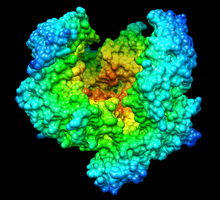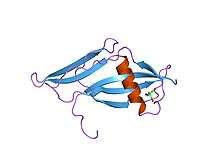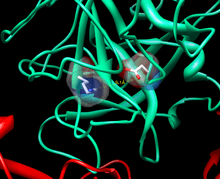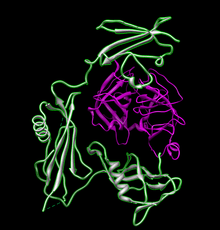Streptokinase
| Streptokinase C | |
|---|---|
 Complex of Catalytic Domain of Human Plasmin and Streptokinase; structure derived from PDB file 1BML. | |
| Identifiers | |
| Symbol | skc |
| Entrez | 8110746 |
| PDB | 1BML |
| UniProt | P00779 |
| Other data | |
| EC number | 3.4.24.29 |
| Staphylokinase/Streptokinase family | |||||||||
|---|---|---|---|---|---|---|---|---|---|
 Structure of staphylokinase, a plasminogen activator.[1] | |||||||||
| Identifiers | |||||||||
| Symbol | Staphylokinase | ||||||||
| Pfam | PF02821 | ||||||||
| InterPro | IPR004093 | ||||||||
| SCOP | 2sak | ||||||||
| SUPERFAMILY | 2sak | ||||||||
| |||||||||
Streptokinase (SK) is an enzyme secreted by several species of streptococci that can bind and activate human plasminogen. SK is used as an effective and inexpensive thrombolysis medication in some cases of myocardial infarction (heart attack)[2] and pulmonary embolism.[3]
Streptokinase belongs to a group of medications known as fibrinolytics, and complexes of streptokinase with human plasminogen can hydrolytically activate other unbound plasminogen by activating through bond cleavage to produce plasmin. There are three domains to streptokinase, denoted α (residues 1–150), β (residues 151–287), and γ (residues 288–414). Each domain binds plasminogen, although none can activate plasminogen independently.[4]
It is on the World Health Organization's List of Essential Medicines, the most important medications needed in a basic health system.[5] The wholesale cost is between 30.00 and 138.00 USD per dose as of 2014.[6] It is no longer available in the United States.[7]
Medical uses
If percutaneous coronary intervention (PCI) is not available within 90-120 minutes of first contact, streptokinase is recommended intravenously as soon as possible after the onset of a ST elevation myocardial infarction (STEMI). As Streptokinase is a bacterial product, the body has the ability to build up an immunity to it. Therefore, it is recommended that this medication should not be used again after four days from the first administration, as it may not be as effective and can also cause an allergic reaction. For this reason, it is usually given only for a person's first heart attack. Further thrombotic events could be treated with Tissue plasminogen activator (tPA). Overdose of streptokinase or tPA can be treated with aminocaproic acid.
Contraindications
- Severe hypertension
- Recent stroke
- Cerebral neoplasm
- Recent history of peptic ulcer disease
- Ulcerative colitis
- Pancreatitis
- Subacute bacterial endocarditis
- Coagulation defects also due to liver or kidney disease
- Recent surgery
- Childbirth.
- Hypersensitivity
- Increased risk of cerebral bleeding
- Trauma
- Pregnancy
- Active internal bleeding
- Bleeding GI lesions
Mechanism of action


Plasmin is produced in the blood to break down fibrin, the major constituent of blood thrombi, thereby dissolving clots once they have fulfilled their purpose of stopping bleeding. Extra production of plasmin caused by streptokinase breaks down unwanted blood clots, for example, in the lungs (pulmonary embolism). The usual activation of Plasminogen (Plgn) is by proteolysis of the Arg561—Val562 bond.[8] The amino group of Val562 then forms a salt-bridge with Asp740, which triggers a conformational change producing the active protease Plasmin (Pm). When (SK) is present, it binds to Plgn to form a complex (SK. Plgn) that converts substrate Plgn to Pm. Residues 1–59 of SK regulate its capacity to induce an active site in bound Pg by a nonproteolytic mechanism and to activate substrate Pg in a fibrin-independent manner. This complex subsequently rearranges to an active complex although the Arg561–Val562 bond remains intact. Therefore, another residue must substitute for the free amino group of Val562 and provide a counterion for Asp740 in this active complex.[9] Two candidates for this counterion have been suggested: Ile1 of streptokinase and Lys698 of Plgn. Deletion of Ile1 of SK markedly inhibits its capacity to induce an active site in plasminogen, which supports the hypothesis that establishment of a salt bridge between Ile1 of SK and Asp740 of plasminogen is necessary for SK to induce an active site in plasminogen by a nonproteolytic mechanism.[10] In contrast with the Ile1 substitutions, the Lys698 mutations also decreased the dissociation constant of the SK complex by 15 to 50 fold. These observations suggest that Lys698 is involved in formation of the initial SK·Plgn complex.[11]
History
After many years of work along with his student Sol Sherry, William Smith Tillett founded the medicine for myocardial infarction in 1933. It is later named as streptokinase.
Research
Streptokinase may find a use in helping to prevent postoperative adhesions, a common complication of surgery, especially abdominal surgery (appendectomy, gall stones, hysterectomy, etc.) One study using animal models (rats) found that when used with a PHBV membrane drug-delivery system, it was 90 percent effective in preventing adhesions.[12] However, it has not been shown to be effective in humans in a clinical trial.
Marketing
It is marketed in Chile as Streptase by Alpes Selection, under license of ZLB Behring from Marburg, Germany.
Available in Viet Nam under the name Mutose. Available in Cuba, Venezuela, Ecuador and other Latin American countries under the trademark Heberkinasa, commercialized by Heber Biotech, Havana, Cuba. Available in India under the name STPase by Cadila Pharmaceuticals Limited & Myokinase by Biocon Limited
References
- ↑ Rabijns A, De Bondt HL, De Ranter C (May 1997). "Three-dimensional structure of staphylokinase, a plasminogen activator with therapeutic potential". Nat. Struct. Biol. 4 (5): 357–60. doi:10.1038/nsb0597-357. PMID 9145104.
- ↑ Sikri N, Bardia A (2007). "A history of streptokinase use in acute myocardial infarction". Tex Heart Inst J. 34 (3): 318–27. PMC 1995058
 . PMID 17948083.
. PMID 17948083. - ↑ Meneveau N, Schiele F, Vuillemenot A, et al. (July 1997). "Streptokinase vs alteplase in massive pulmonary embolism. A randomized trial assessing right heart haemodynamics and pulmonary vascular obstruction". Eur. Heart J. 18 (7): 1141–8. doi:10.1093/oxfordjournals.eurheartj.a015410. PMID 9243149.
- ↑ Mundada L, Prorok, M (2003). "Structure-Function Analysis of Streptokinase Amino Terminus". Journal of Biological Chemistry. 278 (3): 24421–24427. doi:10.1074/jbc.M301825200. PMID 12704199.
- ↑ "WHO Model List of EssentialMedicines" (PDF). World Health Organization. October 2013. Retrieved 22 April 2014.
- ↑ "Streptokinase". International Drug Price Indicator Guide. Retrieved 28 November 2015.
- ↑ "streptokinase (Intravenous route, Intracoronary route)". Truven Health Analytics. Retrieved 28 November 2015.
- ↑ Young, K Shi, G. "Plasminogen Activation by Streptokinase iva a Unique Mechanism". PMID 9446629.
- ↑ Loy, J, Lin,X (2001). "Domain Interactions between Streptokinase and Human Plasminogen". Biochemistry. 48 (3): 14686–14695. doi:10.1021/bio11309d. PMID 11724583.
- ↑ Wang, S, Reed, GL, Hedstrom, L (1999). "Deletion of Ile1 changes the mechanism of streptokinase: evidence for the molecular sexuality hypothesis". Biochemistry. 38 (16): 5232–5240. doi:10.1021/bi981915h. PMID 10213631.
- ↑ Wang X, Lin X (1998). "Crystal Structure of Catalytic Domain of Human Plasmin Complexed with Streptokinase". Science. 281 (3): 1662–1665. doi:10.1126/science.281.5383.1662. PMID 9733510.
- ↑ A. Yagmurlu; M. Barlas; I. Gursel; I.H. Gokcora (2003). "Reduction of Surgery-Induced Peritoneal Adhesions by Continuous Release of Streptokinase from a Drug Delivery System". Eur Surg Res. 35 (1): 46–49. doi:10.1159/000067035. PMID 12566787.